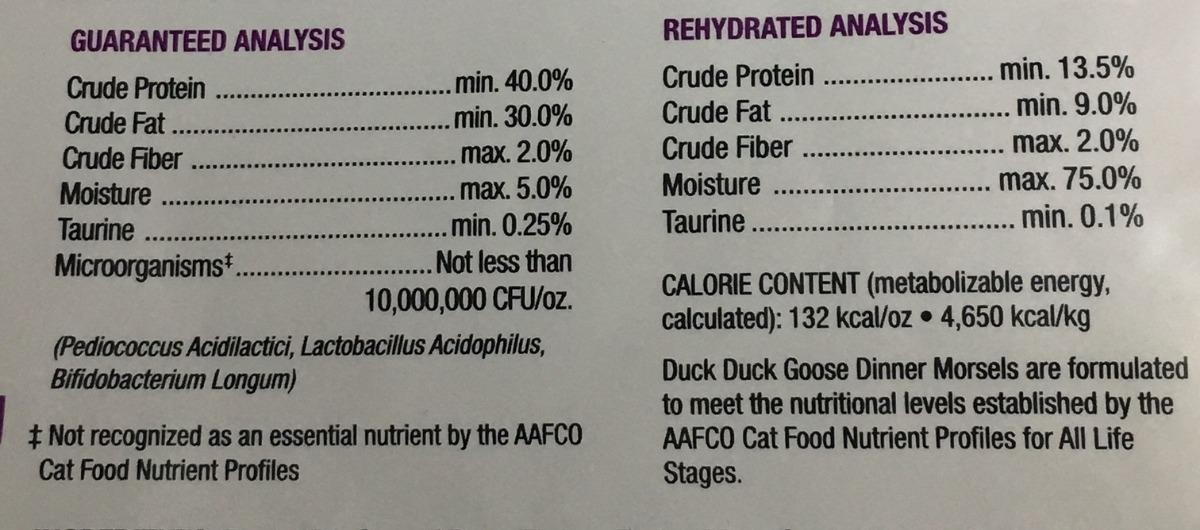Understanding Pet Food Labels -- Pet Nutrition Part II
posted: Jan. 07, 2019.

Understanding Pet Food Labels -- Pet Nutrition Part II
Pet food labels are legal documents in the US, based on rules established by the Association of American Feed Control Officals (AAFCO) www.aafco.org to ensure compliance with federal and state feed laws.
One of the label requirements is the GUARANTEED ANALYSIS which must list the minimum and maximum for the nutrients PROTEIN, FAT, FIBER AND MOISTURE. To meet the requirement, protein and fat must exceed the minimum, while fiber and moisture must exceed the maximum. VITAMINS AND MINERALS are two additional key nutrients that are not required to be listed, but may be present in more detailed analysis provided by the pet food manufacturer. This is an AS FED list.
Although a legal requirement, the GUARANTEED ANALYSIS may hold little value since it doesn't give the TRUE amount of each nutrient. An actual accurate nutrient analysis of the food is more useful, and should be requested from the manufacturer.
Pet food comes in three physical forms: dry, semi-moist and canned. The nutritional quality of the food does not depend on its physical form; good and bad examples of all forms can be produced. The nutrient content of diets can be compared in three different ways:
- AS FED--For diets of similar moisture and calorie content, general comparisons can be made between them
- DRY MATTER BASIS--For diets of differing moisture (especially dry vs canned), but similar calorie content, one can use the amount of nutrient per unit dry matter (DM) BEST WAY TO COMPARE FOODS
- PER 100 KILOCALORIES--For diets of differing calories content (e.g., high vs low fat), compare foods using the amount of nutrients per 100 kcal
COMPARING PET FOODS--DRY MATTER BASIS
Comparing food on a DRY MATTER basis takes the differences in water content out of the equation so nutrients are compared on a common basis. One common misconception is that foods that use fresh meat such as beef, chicken, or turkey have more protein in them than foods that use protein meals because fresh meat is listed first on the ingredient list. Fresh meat is about 75% water, whereas protein meals are essentially dry. If the water is removed from a food that was made with fresh meat and also from one that is made using a protein meal, the foods often contain very similar amounts of protein, with the protein meal food sometimes containing more protein.
Why don't the numbers on a GUARANTEED ANALYSIS add up to 100%? The carbohydrates content is the missing component. One hundred minus the sum of the nutrients listed is understood to be the food's carbohydrate content.
To convert a food from an AS FED (package label) to DRY MATTER BASIS:
- Subtract the moisture content listed on the label from 100 to find the % of Dry Matter (DM)
- Divide the individual nutrients by the % DM to learn the actual amount of nutrient present.
SAMPLE PET FOOD LABELS:
FOOD 1 Guaranteed Analysis
Protein..............16%
Fat.....................12%
Fiber....................5%
Moisture............10%
FOOD 2 Guaranteed Analysis
Protein................15%
Fat........................5%
Fiber.....................1%
Moisture..............76%
FOOD 1: 100%- 10% moisture= 90%DM
FOOD 2: 100%-76% moisture= 24% DM
FOOD 1: 16% Protein/90% DM= 17.8% Protein on DM basis
FOOD 2: 15% Protein/24% DM= 62.5% Protein on DM basis
Now we see that when moisture is removed, FOOD 2 actually contains much more Protein than FOOD 1.
Thanks to Ohio State University College of Veterinary Medicine, Hill's Pet Nutrition, VeterinaryPartner.com and WATT Petfoodindustry.com for the above information.